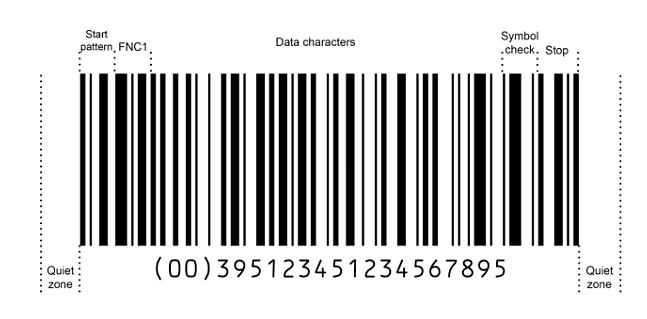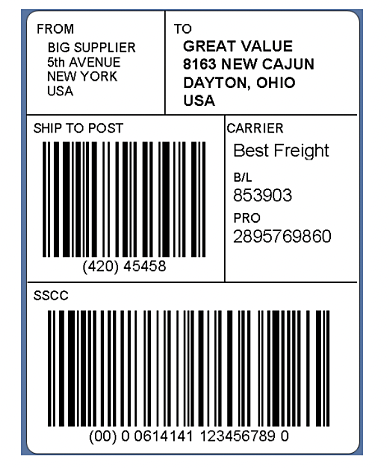Many business owners are familiar with the UPC barcode’s classic black lines and spaces—we see them and use them regularly as shoppers. The same tool that you use to generate UPC barcodes, GS1 US Data Hub®, can also be used to create GS1-128 barcodes for higher levels of packaging that are used in shipping and general distribution. These data rich barcodes are used by most major retailers and can help you track and trace products in the supply chain.
Previously called the UCC-128, the GS1-128 barcode can carry up to 48 characters of information and can include a wide variety of attribute data such as batch/lot information, serial number, expiration date or country of origin. Trading partners often request GS1-128 barcodes on higher levels of packaging beyond the item level to give more specificity to the barcode These are not meant to pass through point of sale because traditional laser scanners cannot read the additional information that this barcode can hold.
How are GS1-128 barcodes used?
GS1-128 Barcodes can carry all of the GS1 Identification keys beyond just the Global Trade Item Number (GTIN). These include Global Location Numbers (GLNs) for identifying parties and locations, Serialized Shipping Container Code (SSCC) to identify logistic units such as cases, pallets, or shipping containers, and GS1 asset Identifiers, and more. Working together, they help identify your products as they travel throughout the supply chain.
Because GS1-128 barcodes can also encode detailed product information such as batch/lot, serial number, or expiration date, which is why they are so beneficial in shipping, receiving, and warehouse scanning environments. If you encode multiple pieces of information in a GS1-128, a single scan of the barcode is all it takes for your supply chain partners (ex., shipper, distributor, fulfillment center) to capture detailed information that not only supports supply chain efficiency, it is a key part of product traceability, helping sellers become better prepared for recalls, too.
For example, the GS1-128 played a key role in Ocean Mist Farms' traceability program.
The components of a GS1-128 barcode
The GS1-128 barcode is a subset of the Code 128 symbology, which contains a flagging character, Function Code 1 (FNC1)). They can also include information through use of Application Identifiers (AIs), which indicate what comes next within the barcode, what format the data will be in, if it will be letters, numbers and special characters, the length of the data, and whether it is fixed or variable length . For example, the AI (01) tells the scanning system “the GTIN is coming next and it will be 14 digits” Application identifiers are both encoded into the barcode and are featured underneath the barcode as numbers in a human readable format.
The GS1-128 barcode contains the following, reading from left to right:
- Left Quiet Zone
- The double character start pattern:
- A start character (A, B, or C)
- The Function 1 Symbol Character (FNC1)
- Data (including the GS1 Application Identifier represented in character set A, B, or C).
- A symbol check character.
- The stop character.
- Right Quiet Zone.

The general format of a GS1-128 barcode.
Example of how a GS1-128 barcode is used in retail
How the GS1-128 barcode is used depends on several factors such as your industry’s specific best practices and what it is you are shipping. It is up to you and your trading partners to decide what information needs to be shared and you should ensure your recipients have the capability to scan a GS1-128 as part of their business processes.
Let’s say you are shipping a carton of juice boxes to a fast food chain. This is what your GS1-128 barcode may look like.

An example of a GS1-128 barcode with GTIN (01), Production Date (11), and Batch/Lot (10)
According to foodservice industry best practices, your GS1-128 barcode should include:
AI (01) for your Global Trade Item Number (GTIN) – The GTIN is used by a company to uniquely identify all its trade items. GS1 defines trade items as products or services that are priced, ordered, or invoiced at any point in the supply chain. When the GTIN is encoded in a GS1-128 barcode, it must be in a 14-digit format preceded by the AI (01).
AI (11) for production date – The production date is the production or assembly date determined by the manufacturer. The date may refer to the trade item itself or items contained. The format for the production date is YYMMDD encoded in the GS1-128 barcode and shown in the text under the barcode.
AI (10) for batch/lot number – The batch/lot number associates an item with information that the manufacturer considers relevant for traceability of the trade item. The batch/lot number is a variable length number consisting of 1-20 characters. Examples of batch/lot numbers could be a production lot number, a shift number, a machine number, a time, or an internal production code, etc.
For other examples of GS1-128 barcodes, please review the General Specifications document, which includes specific guidance on the application of all GS1 Standards.
The GS1-128 barcode shipping label
The GS1-128 barcode is typically included in a GS1 Logistic Label, which is accepted by most major retailers and marketplaces across the globe. The GS1 Logistic Label information may be grouped into separate segments for the supplier, customer, and carrier. The types of data needed for different stops along the supply chain can be expressed in different sections (also called building blocks) in the label.
The label should contain two essential elements: information to be used by people (human readable text and) and information designed for data capture by a machine (barcodes).
This example shows a case label that may be applied at the time of a product’s transport. It contains information on the route and destination, as well as the SSCC encoded in a GS1-128 barcode. The GS1-128 encoding the SSCC is at the bottom building block of the label.

An example of a label with supplier and carrier segments

